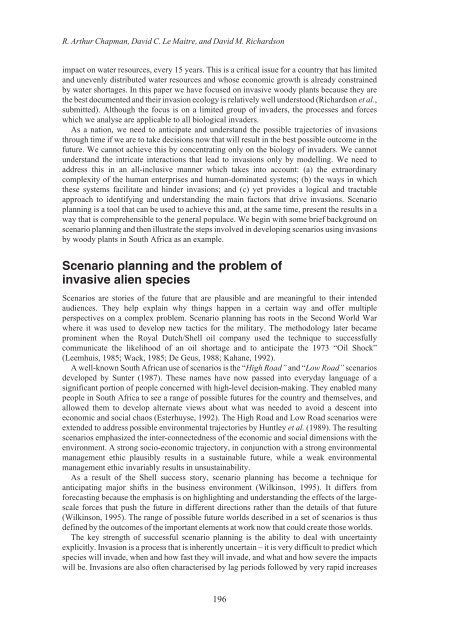Alien Species.vp - IUCN
Alien Species.vp - IUCN
Alien Species.vp - IUCN
Create successful ePaper yourself
Turn your PDF publications into a flip-book with our unique Google optimized e-Paper software.
R. Arthur Chapman, David C. Le Maitre, and David M. Richardson<br />
impact on water resources, every 15 years. This is a critical issue for a country that has limited<br />
and unevenly distributed water resources and whose economic growth is already constrained<br />
by water shortages. In this paper we have focused on invasive woody plants because they are<br />
the best documented and their invasion ecology is relatively well understood (Richardson et al.,<br />
submitted). Although the focus is on a limited group of invaders, the processes and forces<br />
which we analyse are applicable to all biological invaders.<br />
As a nation, we need to anticipate and understand the possible trajectories of invasions<br />
through time if we are to take decisions now that will result in the best possible outcome in the<br />
future. We cannot achieve this by concentrating only on the biology of invaders. We cannot<br />
understand the intricate interactions that lead to invasions only by modelling. We need to<br />
address this in an all-inclusive manner which takes into account: (a) the extraordinary<br />
complexity of the human enterprises and human-dominated systems; (b) the ways in which<br />
these systems facilitate and hinder invasions; and (c) yet provides a logical and tractable<br />
approach to identifying and understanding the main factors that drive invasions. Scenario<br />
planning is a tool that can be used to achieve this and, at the same time, present the results in a<br />
way that is comprehensible to the general populace. We begin with some brief background on<br />
scenario planning and then illustrate the steps involved in developing scenarios using invasions<br />
by woody plants in South Africa as an example.<br />
Scenario planning and the problem of<br />
invasive alien species<br />
Scenarios are stories of the future that are plausible and are meaningful to their intended<br />
audiences. They help explain why things happen in a certain way and offer multiple<br />
perspectives on a complex problem. Scenario planning has roots in the Second World War<br />
where it was used to develop new tactics for the military. The methodology later became<br />
prominent when the Royal Dutch/Shell oil company used the technique to successfully<br />
communicate the likelihood of an oil shortage and to anticipate the 1973 “Oil Shock”<br />
(Leemhuis, 1985; Wack, 1985; De Geus, 1988; Kahane, 1992).<br />
A well-known South African use of scenarios is the “High Road” and “Low Road” scenarios<br />
developed by Sunter (1987). These names have now passed into everyday language of a<br />
significant portion of people concerned with high-level decision-making. They enabled many<br />
people in South Africa to see a range of possible futures for the country and themselves, and<br />
allowed them to develop alternate views about what was needed to avoid a descent into<br />
economic and social chaos (Esterhuyse, 1992). The High Road and Low Road scenarios were<br />
extended to address possible environmental trajectories by Huntley et al. (1989). The resulting<br />
scenarios emphasized the inter-connectedness of the economic and social dimensions with the<br />
environment. A strong socio-economic trajectory, in conjunction with a strong environmental<br />
management ethic plausibly results in a sustainable future, while a weak environmental<br />
management ethic invariably results in unsustainability.<br />
As a result of the Shell success story, scenario planning has become a technique for<br />
anticipating major shifts in the business environment (Wilkinson, 1995). It differs from<br />
forecasting because the emphasis is on highlighting and understanding the effects of the largescale<br />
forces that push the future in different directions rather than the details of that future<br />
(Wilkinson, 1995). The range of possible future worlds described in a set of scenarios is thus<br />
defined by the outcomes of the important elements at work now that could create those worlds.<br />
The key strength of successful scenario planning is the ability to deal with uncertainty<br />
explicitly. Invasion is a process that is inherently uncertain – it is very difficult to predict which<br />
species will invade, when and how fast they will invade, and what and how severe the impacts<br />
will be. Invasions are also often characterised by lag periods followed by very rapid increases<br />
196












